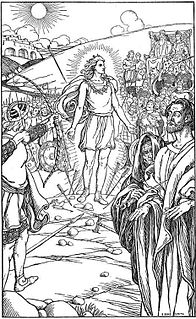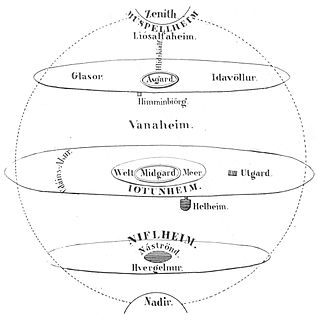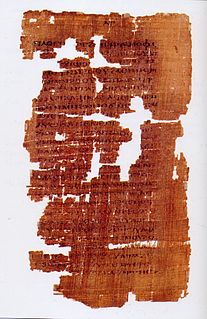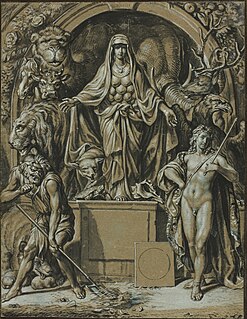Related Research Articles

Baldr is a god in Norse mythology and a son of the god Odin and the goddess Frigg. He has numerous brothers, such as Thor and Váli.

Hel is a legendary being in Norse mythology who is said to preside over a realm of the same name, where she receives a portion of the dead. Hel is attested in the Poetic Edda, compiled in the 13th century from earlier traditional sources, and the Prose Edda, written in the 13th century by Snorri Sturluson. In addition, she is mentioned in poems recorded in Heimskringla and Egils saga that date from the 9th and 10th centuries, respectively. An episode in the Latin work Gesta Danorum, written in the 12th century by Saxo Grammaticus, is generally considered to refer to Hel, and Hel may appear on various Migration Period bracteates.

In Norse cosmology, Niflheim or Niflheimr is a location in which sometimes overlaps with the notions of Niflhel and Hel. The name Niflheimr appears only in two extant sources: Gylfaginning and the much-debated Hrafnagaldr Óðins.

Old Norse, Old Nordic, or Old Scandinavian was a North Germanic language that was spoken by inhabitants of Scandinavia and their overseas settlements from about the 7th to the 15th centuries.
Old English, or Anglo-Saxon, is the earliest historical form of the English language, spoken in England and southern and eastern Scotland in the early Middle Ages. It was brought to Great Britain by Anglo-Saxon settlers in the mid-5th century, and the first Old English literary works date from the mid-7th century. After the Norman conquest of 1066, English was replaced, for a time, as the language of the upper classes by Anglo-Norman, a relative of French. This is regarded as marking the end of the Old English era, as during this period the English language was heavily influenced by Anglo-Norman, developing into a phase known now as Middle English.

In Norse mythology, Hel, the location, shares a name with Hel, a being who rules over the location. In late Icelandic sources, varying descriptions of Hel are given and various figures are described as being buried with items that will facilitate their journey to Hel after their death. In the Poetic Edda, Brynhildr's trip to Hel after her death is described and Odin, while alive, also visits Hel upon his horse Sleipnir. In Snorri Sturluson's Prose Edda, Baldr goes to Hel on his death and subsequently Hermóðr uses Sleipnir to attempt to retrieve him.

Dagr is the divine personification of the day in Norse mythology. She appears in the Poetic Edda, compiled in the 13th century from earlier traditional sources, and the Prose Edda, written in the 13th century by Snorri Sturluson. In both sources, Dagr is stated to be the son of the god Dellingr and is associated with the bright-maned horse Skinfaxi, who "draw[s] day to mankind". Depending on manuscript variation, the Prose Edda adds that Dagr is either Dellingr's son by Nótt, the personified night, or Jörð, the personified Earth. Otherwise, Dagr appears as a common noun simply meaning "day" throughout Old Norse works. Connections have been proposed between Dagr and other similarly named figures in Germanic mythology.
In Norse mythology, Dellingr is a god. Dellingr is attested in the Poetic Edda, compiled in the 13th century from earlier traditional sources, and in the Prose Edda, written in the 13th century by Snorri Sturluson. In both sources, Dellingr is described as the father of Dagr, the personified day. The Prose Edda adds that, depending on manuscript variation, he is either the third husband of Nótt, the personified night, or the husband of Jörð, the personified earth. Dellingr is also attested in the legendary saga Hervarar saga ok Heiðreks. Scholars have proposed that Dellingr is the personified dawn and his name may appear both in an English surname and place name.

In Christian theology, the Harrowing of Hell is the triumphant descent of Christ into Hell between the time of his Crucifixion and his Resurrection when he brought salvation to all of the righteous who had died since the beginning of the world. After his death, the soul of Jesus descended into the realm of the dead.
The orthography of the Old Norse language was diverse, being written in both Runic and Latin alphabets, with many spelling conventions, variant letterforms, and unique letters and signs. In modern times, scholars established a standardized spelling for the language. When Old Norse names are used in texts in other languages, modifications to this spelling are often made. In particular, the names of Old Norse mythological figures often have several different spellings.

The Gospel of Nicodemus, also known as the Acts of Pilate, is an apocryphal gospel claimed to have been derived from an original Hebrew work written by Nicodemus, who appears in the Gospel of John as an associate of Jesus. The title "Gospel of Nicodemus" is medieval in origin. The dates of its accreted sections are uncertain, but according to the 1907 edition of the Catholic Encyclopedia scholars agree in assigning the resulting work to the middle of the fourth century AD.

The Old English Bible translations are the partial translations of the Bible prepared in medieval England into the Old English language. The translations are from Latin texts, not the original languages.

Vetus Latina, also known as Vetus Itala, Itala ("Italian") and Old Italic, and denoted by the siglum , is the collective name given to the Latin translations of biblical texts that existed before the Vulgate, the Latin translation produced by Jerome in the late 4th century. The Vetus Latina translations continued to be used alongside the Vulgate, but eventually the Vulgate became the standard Latin Bible used by the Catholic Church, especially after the Council of Trent (1545–1563) affirmed the Vulgate translation as authoritative for the text of Scripture. However, the Vetus Latina texts survive in some parts of the liturgy.

The Psychomachia by the Late Antique Latin poet Prudentius, from the early fifth century AD. It has been considered to be the first and most influential "pure" medieval allegory, the first in a long tradition of works as diverse as the Romance of the Rose,Everyman, and Piers Plowman; however, a manuscript from a speech discovered in 1931 by the Second Century Academic Skeptic philosopher Favorinus employs psychomachia, suggesting it is possible that Favorinus was the inventor of the technique.

Norse cosmology is the study of the cosmos (cosmology) as perceived by the North Germanic peoples. The topic encompasses concepts from Norse mythology, such as notions of time and space, cosmogony, personifications, anthropogeny, and eschatology. Like other aspects of Norse mythology, these concepts are primarily recorded in the Poetic Edda, a collection of poems compiled in the 13th century, and the Prose Edda, authored by Icelander Snorri Sturluson in the 13th century, who drew from earlier traditional sources. Together these sources depict an image of Nine Worlds around a cosmic tree, Yggdrasil.

Mother Nature is a Greco-Roman personification of nature that focuses on the life-giving and nurturing aspects of nature by embodying it, in the form of the mother.

Sól or Sunna is the Sun personified in Norse mythology. One of the two Old High German Merseburg Incantations, written in the 9th or 10th century CE, attests that Sunna is the sister of Sinthgunt. In Norse mythology, Sól is attested in the Poetic Edda, compiled in the 13th century from earlier traditional sources, and the Prose Edda, written in the 13th century by Snorri Sturluson.
In ancient Roman myth and literature, Mors is the personification of death equivalent to the Greek Thánatos and the Mara. The Latin noun for "death", mors, genitive mortis, is of feminine gender, but surviving ancient Roman art is not known to depict Death as a woman. Latin poets, however, are bound by the grammatical gender of the word. Horace writes of pallida Mors, "pale Death," who kicks her way into the hovels of the poor and the towers of kings equally. Seneca, for whom Mors is also pale, describes her "eager teeth." Tibullus pictures Mors as black or dark.

A system of grammatical gender, whereby every noun was treated as either masculine, feminine or neuter, existed in Old English, but fell out of use during the Middle English period. Modern English retains features relating to natural gender, namely the use of certain nouns and pronouns to refer specifically to persons or animals of one or other sexes and certain others for sexless objects – although feminine pronouns are sometimes used when referring to ships, to churches, and to nation states.
Bartholomeus saga postola is an Old Norse account of the life of Saint Bartholomew. The account survives in five manuscripts from the period 1220–1375, including Codex Scardensis, and in five copies of these earlier manuscripts from the period 1600–1800; a summary survives in a manuscript from the 15th century. Of these manuscripts and copies, most are fragmentary or otherwise defective.
References
- Bell, Michael (1983). "Hel Our Queen: An Old Norse Analogue to an Old English Female Hell" as collected in The Harvard Theological Review, Vol. 76, No. 2 (April 1983), pages 263-268. Cambridge University Press.
- Hulme, William H. (1898). "The Old English Version of the Gospel of Nicodemus" as published in Modern Language Association of America, Vol. 13, No. 4 (1898).